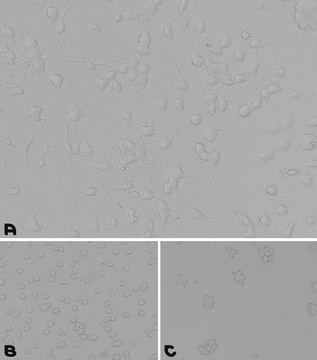LPDL001
Laminin/Poly-D-lysine Coating Solution
0.2 μm filtered, BioReagent, suitable for cell culture, Ready-to-use mixture
Sinônimo(s):
Attachment Factors, Coating mix, Laminin, PDL, Poly-D-lysine
About This Item
Produtos recomendados
Nível de qualidade
esterilidade
0.2 μm filtered
linha de produto
BioReagent
forma
liquid
técnica(s)
cell culture | mammalian: suitable
Condições de expedição
wet ice
temperatura de armazenamento
2-8°C
Descrição geral
Aplicação
- Attachment and spreading of a variety of cell types
- Enhancement of neuronal cell attachment to plastic and glass
- Support of neurite outgrowth
- Suitable for use with serum-free or reduced -serum cultures
Ações bioquímicas/fisiológicas
Componentes
Poly-D-lysine hydrobromide molecular weight is 70,000-150,000 Da, a positively charged amino acid polymer.
Nota de preparo
Código de classe de armazenamento
12 - Non Combustible Liquids
Classe de risco de água (WGK)
WGK 1
Certificados de análise (COA)
Busque Certificados de análise (COA) digitando o Número do Lote do produto. Os números de lote e remessa podem ser encontrados no rótulo de um produto após a palavra “Lot” ou “Batch”.
Já possui este produto?
Encontre a documentação dos produtos que você adquiriu recentemente na biblioteca de documentos.
Conteúdo relacionado
Discover cancer research resources with modeling and profiling tools for cell culture, genomics, biomarkers, and more to help maximize your cancer research.
Nossa equipe de cientistas tem experiência em todas as áreas de pesquisa, incluindo Life Sciences, ciência de materiais, síntese química, cromatografia, química analítica e muitas outras.
Entre em contato com a assistência técnica





